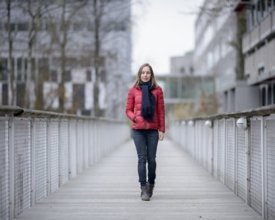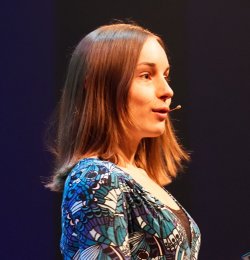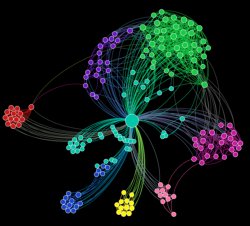SHARING KNOWLEDGE AND ENTHUSIASM THROUGH NETWORKS
Interview with Clara Stegehuis by Diana Dalenoord
 My choice for a university study was between Biomedical Technology and Applied Mathematics. I chose Applied Mathematics and found it so fascinating and challenging that I decided to continue as a mathematical scientist. The great thing about mathematics is that it can be applied to many different fields without the need for complicated equipment; a computer and pen & paper are enough.
My choice for a university study was between Biomedical Technology and Applied Mathematics. I chose Applied Mathematics and found it so fascinating and challenging that I decided to continue as a mathematical scientist. The great thing about mathematics is that it can be applied to many different fields without the need for complicated equipment; a computer and pen & paper are enough.
Projects from society
During my studies, I not only learned theory but also got assignments. I remember a project from my bachelor's where we got an assignment from a company that researched data of different layers in the ground to predict earthquakes. We had to predict where the boundary lines between different strata of the earth were based on measurements at a number of points in the ground. It is exciting to work with a company at the beginning of your studies. I found it fascinating to see how you apply what you have learned and how mathematics can have an impact on society.
Sharing knowledge
These days, I supervise bachelor and master students myself and hope to pass on my enthusiasm for mathematics. One of my students was researching network models for constellations, looking for an answer to the question of how we can mathematically understand how constellations are drawn. Another student is researching epidemic models on networks whose connections can change (e.g. due to lockdown). It is interesting to see how students approach this and how you can give your input.
 Research
Research
I like to communicate my research to a wider audience through blogs, public lectures and teaching. My specialisation lies in probability theory and network science, combined with numerical experiments that investigate large networks. Applications include social media and the internet or networks in your brain. I find it fascinating how a process spreads across a network. I recently looked at contact research: can we calculate how much contact research reduces the r-value during a pandemic? And how does this depend on our network of social contacts?
 Or: what are the small connection patterns that are most important for the functioning of a network? In networks in your body, these small patterns can give clues to the presence of mutations in your cells, but on social media, they can indicate the presence of trolls. These are questions that also have real applications.
Or: what are the small connection patterns that are most important for the functioning of a network? In networks in your body, these small patterns can give clues to the presence of mutations in your cells, but on social media, they can indicate the presence of trolls. These are questions that also have real applications.
Mathematical research is abstract because you work with models and equations and you do not know much about the applications yourself. In practice, you therefore often work together with colleagues from other fields of expertise.
Further plans
This year I received a Veni grant, which allows me to do three years of research into networks with 'high dimensional geometry', which are social networks where you have a lot of information about all the members. I am researching which small patterns in these networks are important for the functioning of the network. I also hope to be able to go to conferences again to discuss research with other scientists, I am looking forward to that!”

ℹ️ Read more about Clara Stegehuis and her research on the Featured Scientist website.
